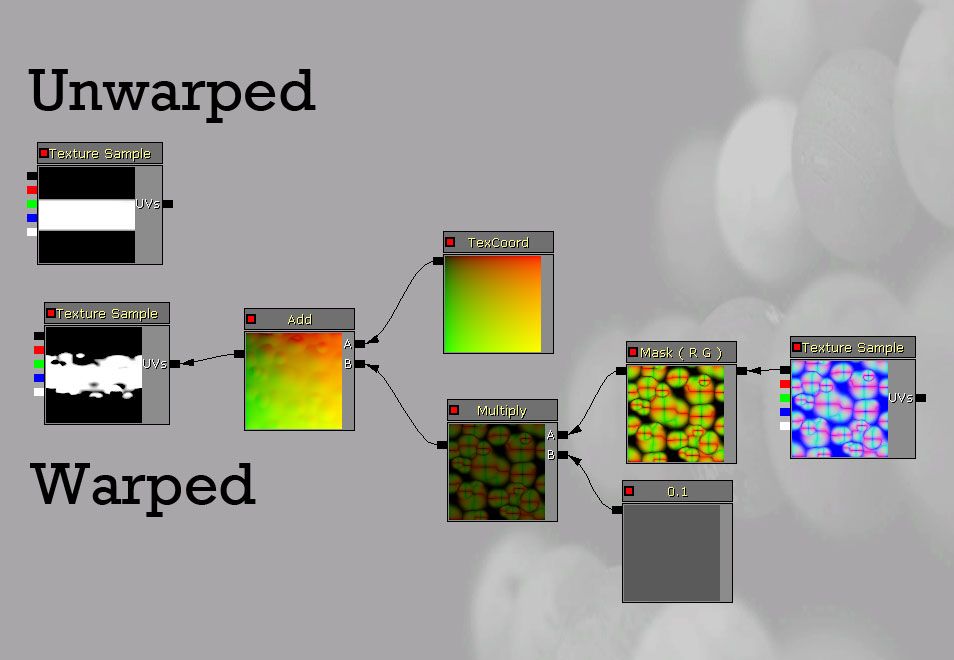The BRAWL² Tournament Challenge has been announced!
It starts May 12, and ends Oct 17. Let's see what you got!
https://polycount.com/discussion/237047/the-brawl²-tournament
It starts May 12, and ends Oct 17. Let's see what you got!
https://polycount.com/discussion/237047/the-brawl²-tournament

Replies
I would look into the forums of Unity, and look how they apply their nodes, I also remember seeing a documentation PDF there.
You could, if you wanted, cut down the number of lines of code, as well:
Now what if I want to use this on particles? How/would that work with a vertex shader?
In Strumpy, the example would be just like the UDK picture, with the following changes:
TextureSample changes to Sampled2D
Mask (RG) may work in Strumpy, if not try Split, then Assemble. Feed Sampled2D into Split, then R and G into Assemble.
Multiply works the same, 0.1 can be a FloatConst (isn't exposed) or a Float (create an input, then it's exposed).
For the top parts, you'll need a Sampler2d and a Tex2d. Add the UV from Sampler2D to the results of the multiply, then feed that into the Tex2D UV input. Connect the top node from Sampler2D to Tex2D.
But the particle systems use fragment shaders anyway, so it works exactly as it does with the code that Tekk gave you (and that I gave you on the Unity forums).
That said, if you've got atlased textures on your particles (for animation or variation) bear in mind that your warp texture will have to be equally atlased, otherwise you'll only sample a small amount of it at any given time.
Most of the examples I've seen of particles use atlased animated textures rather than animating the textures in the shader. Is there a specific reason for this? The hardware Unity shoots for handling larger, atlassed textures better than more expensive shaders perhaps?
Say I wanted to create a flickering flame in Unity. In unreal I would use the above method to warp the uv's of a single, small image and put that animated material on particle sprites. Does that method cross over well?
Again, thanks guys. Switching platforms is always a pain.
(Also, I'd imagine that part of the reason you're seeing that bias is that doing a tutorial with atlassed textures is a bit easier to both prep and grok, than one involving shaders with warping UVs and whatnot, especially given Unity's historically-casual target audience)
SubShader { Pass { CGPROGRAM #pragma vertex vert #pragma fragment frag #pragma fragmentoption ARB_precision_hint_fastest #pragma multi_compile_particles #include "UnityCG.cginc" sampler2D _MainTex; sampler2D _WarpTex; float _WarpInt; float _WarpSpeedX; float _WarpSpeedY; fixed4 _TintColor; struct appdata_t { float4 vertex : POSITION; fixed4 color : COLOR; float2 texcoord : TEXCOORD0; }; struct v2f { float4 vertex : POSITION; fixed4 color : COLOR; float2 uv : TEXCOORD0; #ifdef SOFTPARTICLES_ON float4 projPos : TEXCOORD1; #endif }; float4 _MainTex_ST; float4 _WarpTex_ST; v2f vert (appdata_t v) { v2f o; o.vertex = mul(UNITY_MATRIX_MVP, v.vertex); #ifdef SOFTPARTICLES_ON o.projPos = ComputeScreenPos (o.vertex); COMPUTE_EYEDEPTH(o.projPos.z); #endif o.color = v.color; o.uv = TRANSFORM_TEX(v.texcoord,_MainTex); return o; } sampler2D _CameraDepthTexture; float _InvFade; fixed4 frag (v2f i) : COLOR { #ifdef SOFTPARTICLES_ON float sceneZ = LinearEyeDepth (UNITY_SAMPLE_DEPTH(tex2Dproj(_CameraDepthTexture, UNITY_PROJ_COORD(i.projPos)))); float partZ = i.projPos.z; float fade = saturate (_InvFade * (sceneZ-partZ)); i.color.a *= fade; #endif float2 uvPan = float2(_Time.x * _WarpSpeedX, _Time.x * _WarpSpeedY); float2 warp = tex2D(_WarpTex, i.uv + uvPan) * _WarpInt; return 2.0f * i.color * _TintColor * tex2D(_MainTex, i.uv + warp); } ENDCG } }I want to tile the _WarpTex seperately but I'm not sure where to add in the uv's for that.
Right now I'm giving it the "i.uv" coordinates but that means the uv's for the main texture.
I tried plugging a i.uv2 into the shader but it always kicks back an error.
Any ideas where I would plug in another uv set that comes from my second input?
SubShader { Pass { CGPROGRAM #pragma vertex vert #pragma fragment frag #pragma fragmentoption ARB_precision_hint_fastest #pragma multi_compile_particles #include "UnityCG.cginc" sampler2D _MainTex; sampler2D _WarpTex; float _WarpInt; float _WarpSpeedX; float _WarpSpeedY; fixed4 _TintColor; struct appdata_t { float4 vertex : POSITION; fixed4 color : COLOR; float2 texcoord : TEXCOORD0; }; struct v2f { float4 vertex : POSITION; fixed4 color : COLOR; float2 uv : TEXCOORD0; float2 uv2 : TEXCOORD2; #ifdef SOFTPARTICLES_ON float4 projPos : TEXCOORD1; #endif }; float4 _MainTex_ST; float4 _WarpTex_ST; v2f vert (appdata_t v) { v2f o; o.vertex = mul(UNITY_MATRIX_MVP, v.vertex); #ifdef SOFTPARTICLES_ON o.projPos = ComputeScreenPos (o.vertex); COMPUTE_EYEDEPTH(o.projPos.z); #endif o.color = v.color; o.uv = TRANSFORM_TEX(v.texcoord,_MainTex); o.uv2 = TRANSFORM_TEX(v.texcoord,_WarpTex); return o; } sampler2D _CameraDepthTexture; float _InvFade; fixed4 frag (v2f i) : COLOR { #ifdef SOFTPARTICLES_ON float sceneZ = LinearEyeDepth (UNITY_SAMPLE_DEPTH(tex2Dproj(_CameraDepthTexture, UNITY_PROJ_COORD(i.projPos)))); float partZ = i.projPos.z; float fade = saturate (_InvFade * (sceneZ-partZ)); i.color.a *= fade; #endif float2 uvPan = float2(_Time.x * _WarpSpeedX, _Time.x * _WarpSpeedY); float2 warp = tex2D(_WarpTex, i.uv2 + uvPan) * _WarpInt; return 2.0f * i.color * _TintColor * tex2D(_MainTex, i.uv + warp); } ENDCG } }Since you're here though, I'd love to get the opinion of some more experienced shader peeps. How's this look?
I just edited the default additive particle shader to include a warp texture and use that to warp the uv's for the main texture.
Anything look superfluous or strange?
You might be better doing the UV panning in the vertex shader rather than the fragment shader, though.